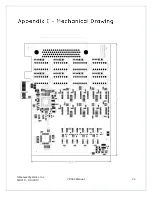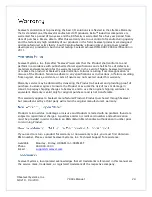
©Sealevel Systems, Inc.
SL9219 – 04/2013
7804e Manual
18
1.
Identify all I/O adapters currently installed in your system. This includes your on-
board serial ports, controller cards, sound cards etc. The I/O addresses used by
these adapters, as well as the IRQ (if any) should be identified.
2.
Configure your Sealevel Systems adapter so that there is no conflict with currently
installed adapters. No two adapters can occupy the same I/O address.
3.
Make sure the Sealevel Systems adapter is using a unique IRQ. While the Sealevel
Systems adapter does allow the sharing of IRQs, many other adapters (i.e. SCSI
adapters & on-board serial ports) do not. The IRQ is typically selected by the BIOS or
operating system. Some BIOS setup software will allow changing the IRQ, but others
do not. Another method of changing assigned resources is to try changing PCIe
slots. This will typically cause the BIOS or OS to reassign the resources.
4.
Make sure the Sealevel Systems adapter is securely installed in a motherboard slot.
5.
When running DOS** or Windows 3.x** refer to the supplied Sealevel Software and
this User Manual to verify that the Sealevel Systems adapter is configured correctly.
This software contains a diagnostic program ‘SSD’
(D:\software\seacom\Other\DOS\DIAG, where D: = the driver letter of your CDROM
drive) will verify if an adapter is configured properly. This diagnostic program is
written with the user in mind and is easy to use. You can use
D:\software\seacom\Other\DOS\PCI\FindPCI.exe to determine resources that have
been assigned to your adapter. Make sure that if available, the ‘Use Plug-n-Play”
option is turned ‘OFF’ in your BIOS. Having this option set to ‘ON’ in DOS or
Windows 3.x will cause erratic operations.
6.
For Windows95/98/ME/NT/2000/XP/Vista/7, the diagnostic tool ‘WinSSD’ is
installed in the SeaCOM folder on the Start Menu during the setup process. First find
the ports using the Device Manager, then use ‘WinSSD’ to verify that the ports are
functional.
7.
Always use the Sealevel Systems diagnostic software when troubleshooting a
problem. This will eliminate any software issues from the equation.







































